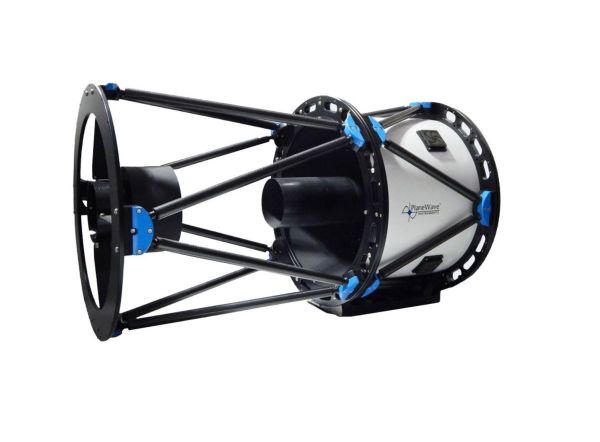PlaneWave Instruments RC24 Ritchey Chretien astrograph f/10.6
PlaneWave Instruments RC24 Ritchey Chretien astrograph f/10.6
The RC24 is a 24 inch (0.61 m) f/10.6 Ritchey-Chrétien (RC) Astrograph telescope. The instrument weight is 240 lbs (108.9 kg) and comes standard with a back plate retaining ring ready to accept the focuser of your choice.
The PW24-RC in its native format (no field flattening lenses) uses only a primary and secondary mirror with reflective coatings. This can be useful when making observations primarily on-axis and wide field imaging is not a concern.
PlaneWave's CDK astrographs have become the telescopes of choice for universities, industry, and astrophotographers around the world, and now PlaneWave offers the PW-RC series to meet the custom needs of the scientific community.
- RC24 Astrograph, 24 inch Astrograph with Fused Silica Optics
- modified to Ritchey-Chrétien, uses only a primary and secondary mirror with reflective coatings
- 8" Dovetail, focal length 6.469 mm (f/10.6)
- Delta T Ready, 3,5" Hedrick Focuser and EFA Kit separately available
- Requires a crating #1323524. The crating will be charged extra
Carbon Fiber Truss Design:
Minimizes thermal expansion which causes focus shift as temperature changes during an imaging session. Carbon fiber also reaches ambient temperatures quickly and is extremely lightweight and rigid to help ensure excellent imaging data is produced.
Ritchey-Chrétien (RC) Optics:
Fused silica RC optics made by PlaneWave for excellent on-axis performance using only a hyperbolic primary and secondary mirror with no refractive optics in the light path.
Dovetail Expansion Joint:
Allows for the difference in thermal expansion between carbon fiber and aluminum. The expansion joint allows the aluminum dovetail to expand and contract without stressing the carbon fiber lower truss. This results in images that are not distorted due to expansion, or contraction of the optical tube materials.
Cooling Fans:
Three fans on the backplate of the optical tube pull air through the telescope and by the primary mirror. Three fans on the side of the optical tube also blow air across the primary to ensure a boundary layer of air does not distort images. These fans help the telescope reach thermal equilibrium quickly, further reducing any distortion in images due to temperature variations. The fans are controlled by a switch on the optical tube, or can be controlled by via PWI3 software if a PlaneWave Electronic Focus Accessory (EFA Kit) is purchased.
Fused Silica is a synthetic amorphous silica glass of the highest purity and one of the most transparent glasses made. The optical and thermal properties of fused silica are superior to other types of glass due to its purity. Its transmission and homogeneity exceed those of crystalline quartz without the problems of temperature instability inherent in the crystalline form. Fused Silica has a coefficient of thermal expansion six times lower than Borosilicate (Pyrex) glass, which means that as fused silica cools down, it preserves its shape to a high degree of accuracy. This translates into consistent optical performance and unchanging focus over temperature changes. With its high melting temperature ()~ 1.600 degree Celsius), a very low coefficient of thermal expansion and resistance to thermal shock, fused silica is the material of choice for professional observatories as well as various scientific applications.
- Optical Design: Ritchey-Chrétien (RC)
- Aperture (mm): 24" (610 mm)
- Focal Length: 6469 mm (254.68 inch)
- Focal Ratio: f/10.6
- Back Focus Distance: 10.3 inch (261.6 mm) from Mounting Surface, 7.3 inch (185.4 mm) from Racked in Focuser
- Central Obstruction: 30% of the Primary Mirror Diameter
- Substrate: Fused Silica
- Optical length: 56 inch (1,422 mm)
- Optical Tube Weight: 240 lbs (108.9 kg)
| Product Status | New |
|---|---|
| Package width | 1016 mm |
| Package height | 1219 mm |
| Package depth | 1981 mm |
| No. of parcels | 1 |





